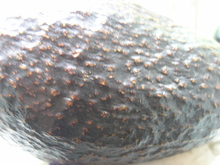 Avo skin. Photo by Jennifer Harington Brizzi
Avo skin. Photo by Jennifer Harington Brizzi
Nutty butter pear
This column appeared April 4, 2007 in the column "Ravenous."
“[The avocado is] one of the most rare and pleasant fruits of the island. It nourisheth and strengtheneth the body, corroborating the spirits and procuring lust exceedingly."
--W. Hughes, physician to King Charles II of England, during a 1672 visit to Jamaica
In the 1920s the avocado had a reputation so racy that its advertisers had to launch a campaign claiming it had absolutely no aphrodisiac powers so that consumers could buy it without embarrassment. Whether folks believed this or not, avocado sales upsurged. And we still love the creamy green things, sliced into sandwiches, squished into guacamole, diced and tossed into salads or pureed into smooth and simple chilled soups.
The avocado is a member of laurel family, and so related to bay leaves. Traces of it that date to 8000 B.C. have been found in Mexico, and its name comes from the Aztec ahuacatl, meaning testicle, because the fruit grows in pairs and dangles as it does. The Aztecs thought the avocado made men strong-like-bull and kept excitable virgins indoors during the harvest. Seamen in the 1700s spread it on their hardtack, earning it the nickname "midshipman's butter," and more recently, in the macramé era, we grew our own houseplants by suspending the pits with toothpicks over water until they sprouted.
Mexican food doyenne Diana Kennedy said that a good ripe avocado should have “the rich flavor of hazelnuts and anise,” but much of its appeal, I think, is its decadently velvety texture and richness from all that healthy monounsaturated fat.
Although there are hundreds of varieties of avocado, by far the most popular is the Hass, that little bumpy wrinkly “alligator pear” whose leathery skin ripens to a purplish-brown-black and is the only avocado variety that is produced year-round.
The Fuerte, which I can’t recall ever buying, is bigger, with a smooth green skin. It has a limited growing season and is milder, waterier and lower in fat than the Hass.
The skinny little seedless “cocktail avocado” is an aberration of other varieties and can be sliced into tiny rounds perfect for canapés or squeezed like toothpaste out of its peel.
The flavor and texture of avocado marries well with citrus and with mild forms of protein like shrimp, crab, lobster, eggs, chicken, turkey or the zestier ham. Lime juice, cayenne, cumin, chives and cilantro flatter it.
You will find it folded into omelets, rolled into sushi, dumped into tacos or quesadillas, pairing with tomatoes and cucumbers in myriad salads or salsas or blended to serve as a salad dressing. Best raw or only slightly warmed (it turns bitter if cooked), it can be sprinkled over soups or chilies just before serving.
It’s great in a sandwich, spread to stand in for mayo, layered with turkey, or added to a BLT to make a BLAT. You’ll find that a half makes a perfect container for tiny shrimp, or a crab or chicken salad. See my recipe below. The Silver Palate Cookbook by Sheila Lukins and Julee Rosso (Workman, 1979) suggests serving sliced avocado with black truffles.
In Africa they’re fond of the creamy non-indigenous fruit, in Kenya making an avocado salad with papaya and red grapefruit, which sounds like a lovely mix of textures of flavors, or in West Africa stuffing halves with a smoked fish salad.
In the French Caribbean they like a fiery appetizer called feroce d’avocat with crabmeat, habanero pepper and avocado. In Latin America where the avocado was born, they adore it. In South America the Colombians put it in ajiaco bogotano, a chicken and potato soup. In Venezuela there’s a casserole of pork chops with almonds, dried fruit, sweet spices and avocado. The Chileans put it on hot dogs and hamburgers, and in Brazil they treat it like the fruit it is, botanically, making it into ice cream or just whipping it up with sugar.
In Guatemala fresh avocados are placed on the table next to the salt for diners to scoop and add to their food as a condiment. In Mexico they make the simplest of soups, with quality avocado blended with the richest chicken stock and chilled. And they toast the anisey leaves in a skillet and then crumble and sprinkle them over dishes for flavor.
Then there’s guacamole. How we love guacamole in this country, at Super Bowl time to the tune of 50 million pounds of avocados. I used to dislike it, still have a love-hate thing going with it, must have had a bad one somewhere. My first guac was a puree over iceberg lettuce at a restaurant in Burlington, Vermont, and I loved it, but since then I’ve grown very picky about my guac. About the only thing various versions have in common is that they contain avocado, which may be chunky dice or pure mush or somewhere in between. Variables considered essential by some and no-nos by others include lemon or lime juice, onions (red, white or yellow), scallions, garlic, diced tomatoes, fresh hot peppers, salsa, chili powder or cilantro. Some heretics add mayo, sour cream, heavy cream, cottage cheese or hard-boiled eggs.
Fruit ‘n nutty avocado oil is a gourmet splash for salads. Parts of the fruit are said to be good for soothing skin and shining hair, and it’s been claimed to cure intestinal parasites, pyorrhea, wounds, neuralgia, hypertension, diarrhea, sore throat, indigestion, coughs, dandruff and toothache. The red-brown milk of the seed was used as ink during the Spanish Conquest on documents that survive today.
Avocados are high in the good fat our bodies need, at 300 calories a pop, but are free of sodium and cholesterol. They’re loaded with fiber, various B vitamins, vitamin C, vitamin E, vitamin K, more potassium than bananas, magnesium, folate, protein, pantothenic acid, iron and copper. Research claims that avocado helps us absorb the alpha-carotene, beta-carotene and lycopene found in other foods and that it ranks relatively low in pesticides, due to the Integrated Pest Management practices of California avocado farmers.
Don’t leave the pit in your guac to keep it from turning brown; it doesn’t work, and citrus juice isn’t much better. Try putting plastic wrap tightly on the surface to keep air out, or better yet, eat it all up!
Chicken Salad-Stuffed Avocados
This makes a simple, refreshing first course or light lunch. Serves two.
1 skinless boneless chicken breast (about 6-7 ounces)
¼ cup Chinese rice wine, sherry, white vermouth or white wine
Sprig of parsley
3 whole peppercorns
Bay leaf
Water to cover (about 2 cups)
1 tablespoon mayonnaise
1 tablespoon yogurt
1 tablespoon chopped fresh Italian parsley
1 tablespoon chopped fresh cilantro
1 tablespoon fresh lime juice
¼ tsp cumin
Pinch of cayenne pepper
Salt and pepper to taste
1 ripe avocado
Lettuce leaves for serving (optional)
1. Rinse chicken breast well. Put wine, parsley sprig, peppercorns and bay leaf in a medium saucepan and add chicken. Add water to barely cover chicken and bring to a simmer. Cover and simmer about 10 minutes or until chicken is firm and cooked through. Let chicken cool in liquid, then remove and cut into ½ inch dice.
2. Toss with mayonnaise, yogurt, parsley, cilantro, lime juice, cumin, cayenne, salt and pepper. Taste for seasoning and chill in refrigerator.
3. Cut avocado in half lengthwise and remove pit with spoon or knife. Place each half on a small plate over optional lettuce leaves. Toss chicken salad once, taste for salt again, and pile it into the avocado hollows. It will overflow but that’s okay.

